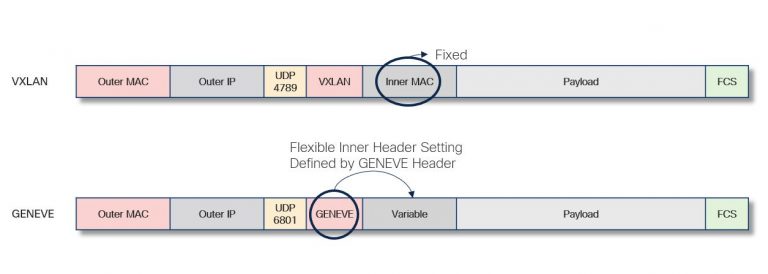- Beyerdynamic's DT 990 Pro headphones get a refresh, promising portability without compromise
- How AI is helping PwC clients comply with European Union sustainability regulations
- The pressure is on for quick AI rollouts - but slow and steady wins this race too
- Forget Otter.ai: ChatGPT just entered the meeting room
- Seven Steps to Building a Mature Vulnerability Management Program
All Tunnels Lead to GENEVE – Cisco Blogs

As a global citizen, I’m sure you came here to read about Genève (French) or Geneva (English), the city situated in the western part of Switzerland. It’s a city or region famous for many reasons including the presence of a Cisco R&D Center in the heart of the Swiss Federal Institute of Technology in Lausanne (EPFL). While this is an exciting success story, the GENEVE I want to tell you about is a different one.
GENEVE stands for “Generic Network Virtualization Encapsulation” and is an Internet Engineering Task Force (IETF) standards track RFC. GENEVE is a Network Virtualization technology, also known as an Overlay Tunnel protocol. Before diving into the details of GENEVE, and why you should care, let’s recap the history of Network Virtualization protocols with a short primer.
Network Virtualization Primer
Over the course of years, many different tunnel protocols came into existence. One of the earlier ones was Generic Routing Encapsulation (GRE), which became a handy method of abstracting routed networks from the physical topology. While GRE is still a great tool, it lacks two main characteristics that hinder its versatility:
- The ability to signal the difference of the tunneled traffic, or original traffic, to the outside—the Overlay Entropy—and allow the transport network to hash it across all available links.
- The ability to provide a Layer-2 Gateway, since GRE was only able to encapsulate IP traffic. Options to encapsulate other protocols, like MPLS, were added later, but the ability to bridge never became an attribute of GRE itself.
With the limited extensibility of GRE, the network industry became more creative as new use-cases were developed. One approach was to use Ethernet over MPLS over GRE (EoMPLSoGRE) to achieve the Layer-2 Gateway use case. Cisco called it Overlay Tunnel Virtualization (OTV). Other vendors referred to it as Next-Generation GRE or NVGRE. While OTV was successful, NVGRE had limited adoption, mainly because it came late to Network Virtualization and at the same time as the next generation protocol, Virtual Extensible LAN (VXLAN), was already making inroads.
VXLAN is currently the de-facto standard for Network Virtualization Overlays. Based on the Internet Protocol (IP), VXLAN also has an UDP header and hence belongs to the IP/UDP-based encapsulations or tunnel protocols. Other members of this family are OTV, LISP, GPE, GUE, and GENEVE, among others. The importance lays in the similarities and their close relation/origin within the Internet Engineering Task Force’s (IETF) Network Virtualization Overlays (NVO3) working group.
Network Virtualization in the IETF
The NVO3 working group is chartered to develop a set of protocols that enables network virtualization for environments that assume IP-based underlays—the transport network. A NVO3 protocol will provide Layer-2 and/or Layer-3 overlay services for virtual networks. Additionally, the protocol will enable Multi-Tenancy, Workload Mobility, and address related issues with Security and Management.
Today, VXLAN acts as the de-facto standard of a NVO3 encapsulation with RFC7348 ratified in 2014. VXLAN was submitted as an informational IETF draft and then become an informational RFC. Even with its “informational” nature, its versatility and wide adoption in Merchant and Custom Silicon made it a big success. Today, we can’t think of Network Virtualization without VXLAN. When VXLAN paired up with BGP EVPN, a powerhouse was created that became RFC8365—a Network Virtualization Overlay Solution using Ethernet VPN (EVPN) that is an IETF RFC in standards track.
Why Do We Need GENEVE if We Already Have What We Need?
When we look to the specifics of VXLAN, it was invented as a MAC-in-IP encapsulation over IP/UDP transport, which means we always have a MAC-header within the tunneled or encapsulated packets. While this is desirable for bridging cases, with routing it becomes unnecessary and could be optimized in favor of better payload byte usage. Also, with the inclusion of an inner MAC-header, signaling of MAC to IP bindings becomes necessary, which needs either information exchanged in the control-plane or, much worse, flood-based learning.

Fast forward to 2020, GENEVE has been selected as the upcoming “standard” tunnel protocol. While the flexibility and extensibility for GENEVE incorporates the GRE, VXLAN, and GPE use-cases, new use-cases are being created on a daily basis. This is one of the most compelling but also most complex areas for GENEVE. GENEVE has a flexible option header format, which defines the length, the fields, and content depending on the instruction set given from the encapsulating node (Tunnel Endpoint, TEP). While some of the fields are simple and static, like bridging or routing, the fields and format used for telemetry or security are highly variable for hop-by-hop independence.
While GENEVE is now an RFC, GBP (Group Based Policy), INT (In-band Network Telemetry) and other option headers are not yet finalized. However, the use-case coverage is about equal to what VXLAN is able to do today. Use cases like bridging and routing for Unicast/Multicast traffic, either in IPv4 or IPv6 or Multi-Tenancy, have been available for VXLAN (with BGP EVPN) for almost a decade. With GENEVE, all of these use-cases are accessible with yet another encapsulation method.

With the highly variable but presently limited number of standardized and published Option Classes in GENEVE, the intended interoperability is still pending. Nevertheless, GENEVE in its extensibility as a framework and forward-looking technology has great potential. The parity of today’s existing use cases for VXLAN EVPN will need to be accommodated. This is how the IETF prepared BGP EVPN from its inception and more recently published the EVPN draft for GENEVE.
Cisco Silicon Designed with Foresight, Ready for the Future
While Network Virtualization is already mainstream, the encapsulating node or TEP (Tunnel Endpoint) can be at various locations. While a tunnel protocol was often focused on a Software Forwarder that runs on a simplified x86 instruction set, mainstream adoption is often driven by the presence of Software as well as Hardware forwarder, the latter built into the switch’s ASIC (Merchant or Custom Silicon). Even though integrated hybrid overlays are still in their infancy, the use of Hardware (the Network Overlay) and Software (the Host Overlay) in parallel are widespread, either in isolation or as ships in the night. Often it is simpler to upgrade the Software forwarder on a x86 server and benefit from a new encapsulation format. While this is generally true, the participating TEPs require consistency for connections needed with the outside world and updating the encapsulation to such gateways is not a simple matter.
In the past, rigid Router or Switch silicon prevented fast adoption and evolution of Network Overlay technology. Today, modern ASIC silicon is more versatile and can adapt to new use cases as operations constantly change to meet new business challenges. Cisco is thinking and planning ahead to provide Data Center networks with very high performance, versatility, as well as investment protection. Flexibility for network virtualization and versatility of encapsulation was one of the cornerstones for the design of the Cisco Nexus 9000 Switches and Cloud Scale ASICs.
We designed the Cisco Cloud Scale ASICs to incorporate important capabilities, such as supporting current encapsulations like GRE, MPLS/SR and VXLAN, while ensuring hardware capability for VXLAN-GPE and, last but not least, GENEVE. With this in mind, organizations that have invested in the Cisco Nexus 9000 EX/FX/FX2/FX3/GX Switching platforms are just a software upgrade away from being able to take advantage of GENEVE.

While GENEVE provides encapsulation, BGP EVPN is the control-plane. As use-cases are generally driven by the control-plane, they evolve as the control-plane evolves, thus driving the encapsulation. Tenant Routed Multicast, Multi-Site (DCI) or Cloud Connectivity are use cases that are driven by the control-plane and hence ready with VXLAN and closer to being ready for GENEVE.
To ensure seamless integration into Cisco ACI, a gateway capability becomes the crucial base functionality. Beyond just enabling a new encapsulation with an existing switch, the Cisco Nexus 9000 acts as a gateway to bridge and route from VXLAN to GENEVE, GENEVE to GENEVE, GENEVE to MPLS/SR, or other permutations to facilitate integration, migration, and extension use cases.
Leading the Way to GENEVE
Cisco Nexus 9000 with a Cloud Scale ASIC (EX/FX/FX2/FX3/GX and later) has extensive hardware capabilities to support legacy, current, and future Network Virtualization technologies. With this investment protection, Customers can use ACI and VXLAN EVPN today while being assured to leverage future encapsulations like GENEVE with the same Nexus 9000 hardware investment. Cisco thought leadership in Switching Silicon, Data Center networking and Network Virtualization leads the way to GENEVE (available in early 2021).
If you are looking to make your way to Geneve or GENEVE, Cisco makes investments in both for the past, present, and future of networking.
Share:

